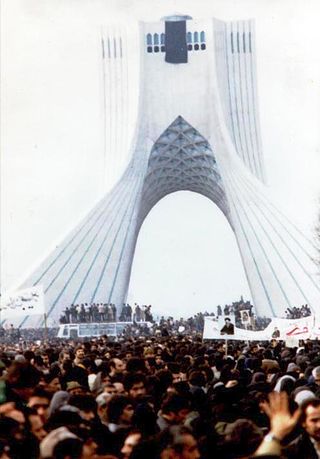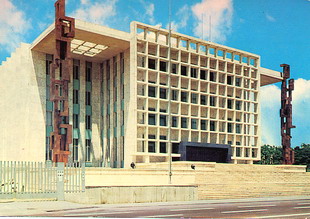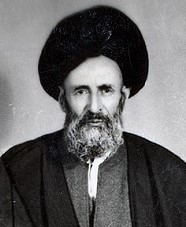
Ruhollah Khomeini, also known as Ayatollah Khomeini, was an Iranian political and religious leader who served as the first supreme leader of Iran from 1979 until his death in 1989. He was the founder of the Islamic Republic of Iran and the leader of the 1979 Iranian Revolution, which saw the overthrow of Shah Mohammad Reza Pahlavi and the end of the Persian monarchy. Following the revolution, Khomeini became the country's first supreme leader, a position created in the constitution of the Islamic Republic as the highest-ranking political and religious authority of the nation, which he held until his death. Most of his period in power was taken up by the Iran–Iraq War of 1980–1988. He was succeeded by Ali Khamenei on 4 June 1989.

The Iranian Revolution, or the Islamic Revolution, refers to a series of events that culminated in the overthrow of the Pahlavi dynasty in 1979. It led to the replacement of the Imperial State of Iran by the present-day Islamic Republic of Iran, as the monarchical government of Mohammed Reza Pahlavi was superseded by the theocratic government of Ruhollah Khomeini, a religious cleric who had headed one of the rebel factions. The ouster of Pahlavi, the last Shah of Iran, formally marked the end of Iran's historical monarchy.

The White Revolution or the Shah and People Revolution was a far-reaching series of reforms resulting in aggressive modernization in Iran launched on 26 January 1963 by the Shah, Mohammad Reza Pahlavi, which lasted until 1979. The reforms resulted in a great redistribution of wealth to Iran's working class, explosive economic growth in subsequent decades, rapid urbanization, and deconstruction of Iran's feudalist customs.

The National Front of Iran is an opposition political organization in Iran, founded by Mohammad Mosaddegh in 1949. It is the oldest and arguably the largest pro-democracy group operating inside Iran despite having never been able to recover the prominence it had in the early 1950s.

Ayatollah Taqi Mesbah, commonly known as Mohammad-Taqi Mesbah-Yazdi was an Iranian Shi'i cleric, philosopher and conservative political theorist who served as the spiritual leader of the Front of Islamic Revolution Stability.

The demonstrations of June 5 and 6, also called the events of June 1963 or the 15 Khordad uprising, were protests in Iran against the arrest of Ayatollah Ruhollah Khomeini after his denouncement of Iranian Shah Mohammad Reza Pahlavi and Israel. The Shah's regime was taken by surprise by the massive public demonstrations of support, and although these were crushed within days by the police and military, the events established the importance and power of (Shia) religious opposition to the Shah, and Khomeini as a major political and religious leader. Fifteen years later, Khomeini was to lead the Iranian Revolution which overthrew the Shah and the Pahlavi dynasty and established the Islamic Republic of Iran.

A referendum on creating an Islamic Republic was held in Iran on 30 and 31 March 1979.

Many organizations, parties and guerrilla groups were involved in the Iranian Revolution. Some were part of Ayatollah Khomeini's network and supported the theocratic Islamic Republic movement, while others did not and were suppressed when Khomeini took power. Some groups were created after the fall of the Pahlavi Dynasty and still survive; others helped overthrow the Shah but no longer exist.

The Assembly for the Final Review of the Constitution also known as the Assembly of Experts for Constitution, was a constituent assembly in Iran that was convened in 1979 to condense and ratify the draft prepared beforehand for the Constitution of the Islamic Republic of Iran.
The consolidation of the Iranian Revolution refers to a turbulent process of Islamic Republic stabilization, following the completion of the Islamic revolution. After the Shah of Iran and his regime were overthrown by Islamic revolutionaries in February 1979, Iran was in a "revolutionary crisis mode" from this time until 1982 or 1983. Its economy and the apparatus of government collapsed. Military and security forces were in disarray.
Premiership of Mir-Hossein Mousavi were the third and fourth government of Iran after the Iranian Revolution. At that time, Ali Khamenei was the president.
The Imperial state of Iran, the government of Iran during the Pahlavi dynasty, lasted from 1925 to 1979. During that time two monarchs — Reza Shah Pahlavi and his son Mohammad Reza Shah Pahlavi — employed secret police, torture, and executions to stifle political dissent. The Pahlavi dynasty has sometimes been described as a "royal dictatorship", or "one-man rule". According to one history of the use of torture by the state in Iran, abuse of prisoners varied at times during the Pahlavi reign.

The Interim Government of Iran was the first government established in Iran after the Iranian Revolution. The regime was headed by Mehdi Bazargan, one of the members of the Freedom Movement of Iran, and formed on the order of Ruhollah Khomeini on 4 February 1979. From 4 to 11 February, Bazargan and Shapour Bakhtiar, the Shah's last Prime Minister, both claimed to be the legitimate prime minister; Bakhtiar fled on 11 February. Mehdi Bazargan was the prime minister of the interim government and introduced a seven-member cabinet on 14 February 1979. Ebrahim Yazdi was elected as the Foreign Minister.
A referendum on the dissolution of Parliament, the first referendum ever held in Iran, was held in August 1953. The dissolution was approved by more than 99% of voters.
A constitutional referendum was held in Iran on 2 and 3 December 1979. The new Islamic constitution was approved by 99.5% of voters.

Ahmad Khonsari, also Aḥmad Khvānsārī, or Khvunsārī was an Iranian Grand Ayatollah and attained marja status after the death of marja Boroujerdi in 1961. In contrast to the other maraji of his time, who lived in the holy cities of Qom or Najaf, he was based in Tehran, where he ran his own hawza. Khonsari was one of the teachers of Ayatollah Khomeini.

Ruhollah Khomeini’s return to Iran on 1 February 1979, after 14 years in exile, was an important event in the Iranian Revolution. It led to the collapse of the provisional government of Shapour Bakhtiar and the final overthrow of the Shah of Iran, Mohammad Reza Pahlavi, on 11 February 1979.

Feyziyya School is an old school in Iran that was founded in the Safavid era. The school has been listed as one of Iran's national monuments as of January 29, 2008. The school served as a focal point for clerical opposition to Mohammad Reza Shah Pahlavi's White Revolution. In 1963 on Ashura, Ayatollah Ruhollah Khomeini delivered a speech at the school denouncing the Shah, and was arrested as a result.

The Government of the Islamic Republic of Iran is the ruling state and current political system in Iran, in power since the Islamic revolution and fall of the Pahlavi dynasty in 1979.

Ruhollah Khomeini's life in exile was the period that Grand Ayatollah Ruhollah Khomeini spent from 1964 to 1979 in Turkey, Iraq and France, after Mohamed Reza Shah Pahlavi had arrested him twice for dissent from his “White Revolution” announced in 1963. Ayatollah Khomeini was invited back to Iran by the government, and returned to Tehran from exile on 1979.













